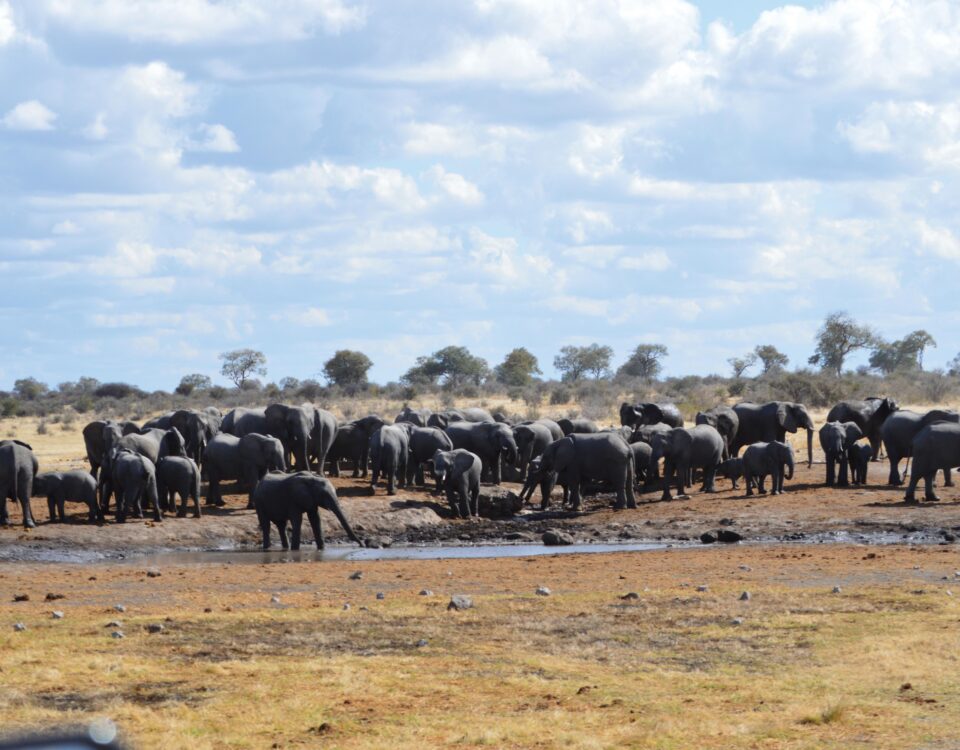Alte Kalköfen Lodge
July 20, 2012Fishing in Namibia
July 24, 2012Nature Notes on Etosha elephants
Main photograph – Paul van Schalkwyk.
by Amy Schoeman
Before the first Europeans came to Namibia, elephants probably occurred in Etosha on a seasonal basis, depending on the availability of food and water. According to reports of explorers who visited the area in the 1850s, elephants occurred there commonly. The advent of modern firearms, however, proved fatal to their survival. They were shot in such large numbers that by the 1880s none was left in the area.
The position remained unchanged until 1984, when small numbers started making their appearance at Rietfontein and Namutoni. A count in 1954 revealed there was a total of 26 in the park. Bernabé de la Bat, then chief game warden in Etosha, devised a plan to attract elephants from the Kamanjab district, where they had been causing extensive damage on the farms. A series of boreholes were sunk along the 19th latitude over a distance of 200 km, which lured hundreds of elephants into the park. By the 1980s they had increased to between 1 000 and 3 000, the result of breeding as well as migration.
Etosha’s elephants are of the largest in Africa, the tallest measuring up to four metres at the shoulder. Adult bulls have a mass of between 5 500 and 6 000 kg, while the cows have about two-thirds of the mass of the bulls in the same area.
Their tusks on the other hand, are smaller than those of elephants elsewhere in Africa. This is ascribed to breakages resulting from mineral deficiencies in their diet and genetic defects. The fact that Etosha’s elephants have smallish tusks is a distinct advantage, in so far as this makes them less likely to fall prey to ivory poachers.
The elephant’s tusks are specialised incisor teeth consisting of dentine (ivory) surrounded by a thin layer of enamel, which wears away as the tooth grows. The tusks continue to grow throughout the elephant’s lifetime, having erupted when the calf is about three years old. Tusks are usually asymmetrical, the one more worn than the other, and are used for ripping bark off trees, as a support when bending branches, occasionally as a digging tool, and as a formidable weapon. Although a bull is quite capable of driving its tusks into the brain of an adversary, deaths from elephant fights hardly ever occur.
Where a supply of clean, fresh water is normally an essential habitat requirement for elephants, in Etosha they have adapted to the water with its high salt content, the salinity of which sometimes exceeds that of seawater. Elephants are both browsers and grazers. In Etosha they feed especially on mopane, having a preference for re-growth from previously damaged trees. They also consume underground bulbs, tubers and roots, which they dig out with their feet, for the food as well as the water content.
 During the rainy season Etosha’s elephants concentrate in areas away from permanent waterholes, because the vegetation around the water is under pressure all year round. This seasonal distribution pattern is advantageous for both the elephants and the vegetation and prevents the overexploitation of the habitat in one area.
During the rainy season Etosha’s elephants concentrate in areas away from permanent waterholes, because the vegetation around the water is under pressure all year round. This seasonal distribution pattern is advantageous for both the elephants and the vegetation and prevents the overexploitation of the habitat in one area.
This article appeared in the Oct/Nov ‘04 edition of Travel News Namibia.





